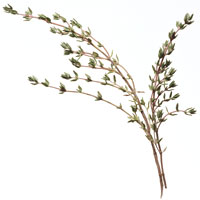Search Healthnotes
Thyme

Preparation, Uses, & Tips
Whatever the variety, thyme is widely used in cooking to add flavor to vegetables, meat, poultry and fish dishes, soups, stews, and cream sauces. It’s a basic herb of French cuisine and integral to the bouquet garni—a bunch of herbs (the classic trio being parsley, thyme, and bay leaf) that is either tied together with string or placed in a cheesecloth bag and used to flavor soups, stews, and broths. With garlic, nothing can substitute for thyme in the classic French beef stew called Boeuf Bouguignon. When used with a light hand, it is also good in bean dishes. In Greek cooking, thyme goes well with other seasonings, such as oregano and dill.
Thyme dries better than most herbs. It retains much of its flavor and does not develop the dry, straw-like taste that develops among many herbs when dried. When using thyme in a salad, fresh is a better choice than dried.
Thyme is especially compatible with marjoram, summer savory, celery leaves, and parsley, and it goes well with vegetables of the cabbage family, as well as potatoes, tomatoes, zucchini, and eggplant.
Lastly, thyme can easily overpower other, more delicate flavors, so it should be used with a light hand. It’s a good choice for slowly cooked dishes, where it is less likely to dominate other seasonings.
Copyright © 2024 TraceGains, Inc. All rights reserved.
Learn more about TraceGains, the company.
The information presented in the Food Guide is for informational purposes only and was created by a team of US–registered dietitians and food experts. Consult your doctor, practitioner, and/or pharmacist for any health problem and before using any supplements, making dietary changes, or before making any changes in prescribed medications. Information expires December 2024.











